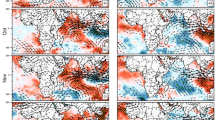Abstract
The Northern Indian Ocean (NIO) is unique due to seasonal reversal of wind patterns, the formation of vortices and eddies which make satellite observations arduous. The veracity of sea surface wind (SSW) and sea surface temperature (SST) products of sun-synchronous AMSR-2 satellite are compared with high-temporal moored buoy observations over the NIO. The two year-long (2013–2014) comparisons reveal that the root-mean-square-error (RMSE) of AMSR-2 SST and SSW is \(<0.4{^{\circ }}\hbox {C}\) and \(<1.5\hbox { ms}^{-1}\), respectively, which are within the error range prescribed for the AMSR-2 satellite (\(\pm 0.8{^{\circ }}\hbox {C}\), \(\pm 1.5\hbox { ms}^{-1})\). The SST–wind relation is analyzed using data both from the buoy and satellite. As a result, the low-SST is associated with low-wind condition (positive slope) in the northern part of the Bay of Bengal (BoB), while low SST values are associated with high wind conditions (negative slope) over the southern BoB. Moreover, the AMSR-2 displayed larger slope for SST–wind relation and could be mainly due to overestimation of SST and underestimation of wind as compared to the buoy. The AMSR-2 SSW exhibited higher error during post-monsoon followed by monsoon season and could be attributed to the high wind conditions associated with intense oceanic vortices. The study suggests that the AMSR-2 products are reliable and can be used in tropical air–sea interactions, meso-scale features, and weather and climate studies.





Similar content being viewed by others
References
Bhat G S, Vecchi G A and Gadgil S 2004 Sea surface temperature of the Bay of Bengal derived from the TRMM Microwave Imager; J. Atmos. Ocean. Tech. 21 1283–1290.
Chatterjee A, Shankar D, Shenoi S S C, Reddy G V, Michael G S and Ravichandran M et al. 2012 A new atlas of temperature and salinity for the North Indian Ocean; J. Earth Syst. Sci. 121(3) 559–593.
Dong S, Gille S T, Sprintall J and Gentemann C 2006 Validation of Advanced Microwave Scanning Radiometer for the Earth Observing System (AMSR-E) sea surface temperature in the Southern Ocean; J. Geophys. Res. 111 C04002, https://doi.org/10.1029/2005JC002934.
Gentemann C L and Hilburn K A 2015 In situ validation of sea surface temperatures from the GCOM-W1 AMSR2 RSS calibrated brightness temperatures; J. Geophys. Res. 120 3567–3585.
Hilburn K and D K Smith 2013 Validation and early science from AMSR-2, AGU fall meeting, 2013, OS41A-1804, http://adsabs.harvard.edu/abs/2013AGUFMOS41A1804H.
Imaoka K, Kachi M, Kasahara M, Ito N, Nakagawa K and Oki T 2010 Instrument performance and calibration of AMSR-E and AMSR2; ISPRS. xxxviii, part 8.
Kachi M, Hori M, Maeda T and Imaoka K 2014 Status of validation of AMSR-2 on board the GCOM-W1 satellite; IEEE Geoscience and Remote Sensing Symposium, pp. 110–113, https://doi.org/10.1109/IGARSS.2014.6946368.
Latif M, Roeckner E, Botzet M, Esch M, Haak H, Hagemann S, Jungclaus J, Legutke S, Marsland S, Mikolajewicz U and Mitchell J 2004 Reconstructing, monitoring, and prediciting multidecadal-scale changes in the North Atlantic thermohaline circulation with sea surface temperature; J. Clim. 17 1605–1614.
Neetu S, Lengaigne M, Vincent E M, Vialard J, Madec G and Samson G et al. 2012 Influence of upper-ocean stratification on tropical cyclone-induced surface cooling in the Bay of Bengal; J. Geophys. Res.: Oceans 117(C12).
Parekh A and Sarkar A 2009 Co-variation in subskin-bulk temperature difference with environmental parameters in the north Indian Ocean Int. J. Remote Sens. 30 2049–2059.
Parekh A, Sharma R and Sarkar A 2007 A comparative assessment of sea surface temperature and surface wind speed over the Indian Ocean by TMI, MSMR, and ERA-40; J. Atmos. Oceanic Tech. 24 1131–1142.
Sengupta D, Bharath Raj G N, Ravichandran M, Sree Lekha J and Papa F 2016 Near-surface salinity and stratification in the north Bay of Bengal from moored observations; Geophys. Res. Lett. 43(9) 4448–4456.
Sharma R, Babu K N, Mathur A K and Ali M M 2002 Identification of large-scale atmospheric and oceanic features from IRS-P4 multifrequency scanning microwave radiometer: Preliminary results; J. Atmos. Ocean. Tech. 19 1127–1134.
Singh P, Parekh A and Attada R 2013 Comparison of a simple logarithmic and equivalent neutral wind approaches for converting buoy-measured wind speed to the standard height: Special emphasis to North Indian Ocean; Theor. Appl. Climatol. 111(3) 455–463.
Sutton R T and Hodson D L 2003 Influence of the ocean on North Atlantic climate variability 1871–1999; J. Clim. 16 3296–3313.
Tomita H, Kawai Y, Cronin M F, Hihara T and Kubota M 2015 Validation of AMSR-2 sea surface wind and temperature over the Kuroshio Extension Region; SOLA 11 43–47, https://doi.org/10.2151/sola.2015-010.
Venkatesan R, Shamji V R, Latha G, Mathew S, Rao R R, Muthiah A and Atmanand M A 2013 In situ ocean subsurface time-series measurements from OMNI buoy network in the Bay of Bengal; Curr. Sci. 104(9) 1166–1177.
Weller R A, Farrar J T, Buckley J, Mathew S, Venkatesan R and Lekha J S et al. 2016 Air–sea interaction in the Bay of Bengal; Oceanography 29(4) 28–37.
Xie S P, Annamalai H, Schott F A and McCreary Jr J P 2002 Structure and mechanisms of south Indian Ocean climate variability; J. Clim. 15 864–878.
Acknowledgements
The authors gratefully acknowledge the financial support from the SERB (ECR/2016/001637), Department of Science & Technology, Govt. of India. We thank Dr Wentz F J of Remote Sensing Systems for making the AMSR-2 SST and wind speed 3-day average product available on their website www.remss.com/missions/amsre. Freeware Ferret and NCL are used in this study. The authors are also thankful to the Ministry of Earth Sciences (MoES), Govt. of India, for maintaining the moored buoy network over the NIO. The authors also thank the anonymous reviewers for their constructive and valuable suggestions that helped to improve the quality of the manuscript.
Author information
Authors and Affiliations
Corresponding author
Additional information
Corresponding editor: D Shankar
Rights and permissions
About this article
Cite this article
Reddy, B.N.K., Venkatesan, R., Osuri, K.K. et al. Comparison of AMSR-2 wind speed and sea surface temperature with moored buoy observations over the Northern Indian Ocean. J Earth Syst Sci 127, 14 (2018). https://doi.org/10.1007/s12040-017-0902-3
Received:
Revised:
Accepted:
Published:
DOI: https://doi.org/10.1007/s12040-017-0902-3




